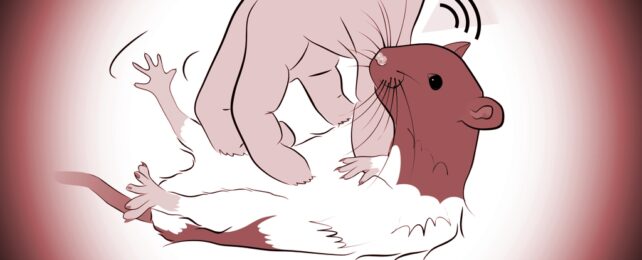Playful behavior was once considered a rare phenomenon in the animal kingdom, and yet recent evidence suggests birds, bees, apes, marsupials, lizards, turtles, crocodiles, and maybe even fish can all engage in play.
A new study on the 'rough and tumble' play of young rats supports the idea that social amusement is instinctual among mammals and possibly others, too.
When researchers in Germany tickled and chased 'giggling' rodents around an open cage, they noticed a part of the rat brain, known as the periaqueductal gray matter (PAG), was especially active.
This midbrain region is one of the most ancient and preserved parts of the animal brain. Present in mammals, reptiles, fish, and insects, it is often involved in responses to pain and other threats. It is also closely tied to animal vocalizations.
When the lateral column of the PAG was artificially inhibited in adolescent rodents, researchers in Germany noticed that the rats squeaked less when tickled on the belly and back.
After this bout of tickling, the inhibited rats were also less likely to chase the same human hand around their cage in a playful and non-aggressive way.
"We know that vocalizations such as laughter are very important in play, which supported the idea that there is some sort of organization signal in the brain regulating this behavior," explains neuroscientist Michael Brecht from Humboldt-University in Berlin.
"For example, children check for laughter when they play-fight with each other. If their playmate isn't laughing anymore, they stop fighting."
Rats, of course, don't laugh like human children, but when they are amused, they squeak at frequencies we can't hear.
Past studies strongly suggest that the more ticklish a rat is, the more playful it tends to be.
As such, rodents are an invaluable model of animal play that is easily quantified and strictly regulated.
Brecht and his colleagues have studied rat ticklishness for years, but they've only started unraveling the specifics.
The behavioral changes seen in their newest experiments are apparently "massive" and strongly suggest PAG neurons are somehow related to play.
"Our blocking experiments support the idea that a properly functioning PAG is required for play and ticklishness," the researchers write.
When Brecht and his colleagues placed rats in a stressful, new environment, the animals showed less inclination for play.
This suggests that their PAG can only 'focus' on playful behavior when they are not already occupied by immediate flight-or-fight responses.
In all likelihood, the brain axis for ticklish play involves the PAG and other brain regions associated with memory, emotion, sensory responses, and decision-making.
"Our understanding of the neural mechanisms of play control in the PAG is in its infancy," the authors of the study admit.
"Although our data firmly establish the role of the PAG in play control, we emphasize that it is not yet clear how play is implemented in these neural circuits."
Researchers now want to study whether the PAG is similarly involved in the play of other animal species and whether this brain region can grow stronger from momentary bouts of amusement.
The study was published in Neuron.
